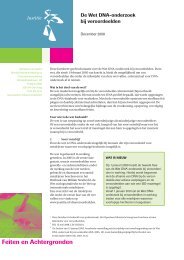INTERPOL HANDBOOK ON DNA DATA EXCHANGE AND PRACTICE
INTERPOL HANDBOOK ON DNA DATA EXCHANGE AND PRACTICE
INTERPOL HANDBOOK ON DNA DATA EXCHANGE AND PRACTICE
Create successful ePaper yourself
Turn your PDF publications into a flip-book with our unique Google optimized e-Paper software.
With the increasing use of <strong>DNA</strong> profiling by countries (there has been a 126% increasesince 1999), more and more countries are relying upon national databases to store,manage and compare their <strong>DNA</strong> profiles. When the first <strong>DNA</strong> Databases weredeveloped in the mid-1990s, their potential value for police investigations was not fullyappreciated. The consequent advantages for police investigations in terms of solvingcrime continue to encourage the development of national <strong>DNA</strong> Databases across theglobe. This trend can be seen in Figure 6, which illustrates how the number of membercountries with a national <strong>DNA</strong> Database increased by 38 (238%) between 1999 and2008.Figure 6: Global increase in <strong>DNA</strong> profiling and databasing over the period surveyed,from 1999 to 2008.Initially, many countries restricted the upload of <strong>DNA</strong> profiles into their nationaldatabases on the basis of the type of crime scene from which biological evidencewas taken (e.g. violent crime). Criteria were also applied to individuals’ profiles to beentered into the database, for example, convicted offenders often had to have beenserved a minimum prison sentence.Many countries have expanded their criteria to allow for the inclusion of more crimetypes and person profiles, which in some countries may include any recordable offence.Likewise, in many countries the criteria for entering a person’s profile is not merelyrestricted to convicted offenders but may also include suspects. Countries also usenational <strong>DNA</strong> Databases to match other profile categories such as unidentified bodiesand missing persons. A global comparison of the main profiling categories showsthat, according to the <strong>INTERPOL</strong> <strong>DNA</strong> survey replies, the one category used by allcountries for <strong>DNA</strong> profiling is ‘Crime Scene’, and the highest number of <strong>DNA</strong> profilesis produced for the known offender category.STATUS <strong>ON</strong> EXISTINGNATI<strong>ON</strong>AL <strong>DNA</strong> <strong>DATA</strong>BASESPAGE 53







